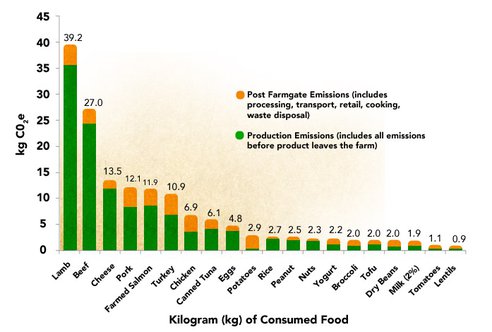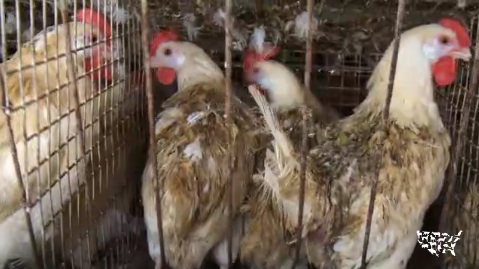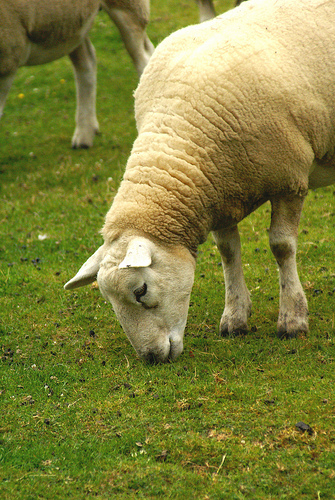This post is part of Protein Angst, a series on the environmental and nutritional complexities of high-protein foods. Our goal is to publish a range of perspectives on these very heated topics. Add your feedback and story suggestions here.

Photo by Martin Pettitt.
When it comes to carbon emissions, lamb is said to be the worst possible thing to eat. It’s the tall, scary skyscraper in the carbon emissions bar graph (see below), and for good reason. They’re small, gassy animals that spend most of their lives on pasture. Wait, what’s that last part? Yes, some of the animals who seem to spend the least time in concentrated animal feeding operations (CAFOs) — a good thing, as far as I’m concerned — also have the largest carbon hoofprints.
It’s a given that eating any meat at all has a larger environmental impact than choosing not to. But, for committed omnivores, choosing a comparatively green option has become increasingly complex. And precisely because lamb has gotten such a bad rap in carbon-centric circles, I thought it might be worth another look.
First the bad news: Sheep are big burpers and, like cows, they release a lot of methane into the atmosphere. Although their production “lifecycle” has around the same climate impact as that of cattle, the Environmental Working Group (EWG) reports that “lamb meat tends to have higher net GHG emissions because lambs produce less meat in relation to live weight than cows.”
As Susan Schoenian, a sheep and goat specialist at the University of Maryland Extension, put it in a recent email:
In reality, the carbon footprint is highest in the agricultural enterprises that are the least efficient, i.e. organic and pasture-based. Why? It takes so much longer on pasture for a calf to reach market size. Each extra day the calf lives, he drinks water, urinates, poops, and belches methane gas.
Of course there are many variables at play, she says, but the main factor is the amount of time sheep spend out on grass (a production method that is often highly valued otherwise). “We still have lambs in feedlots,” she added, when I spoke to her recently, “but a higher percentage of lambs are finished on grass.”
A study out of Australia [PDF], where the sheep and lamb industry has become increasingly industrialized or “efficient” as Schoenian might say, supports this idea.
A high percentage of Australian lambs are “finished” on grain (i.e. fed grain near the end of their lives for extra weight gain and to impact the flavor/fat content of the meat), but the time they spend in feedlots is much lower than cows in that area.
“Cattle spend between 100 and 180 days in a feedlot,” the study reads, whereas lambs “usually spend 4 weeks in confinement feeding on high grain diets.”

But the fact that sheep spend relatively less time in CAFOs isn’t all there is to it. Here in the States, many of the largest herds of sheep also graze on public lands, where they control underbrush (and prevent fires) and invasive weeds. They’ve also been known to help repair watersheds and riparian areas. And — interestingly — they often eat leftover crops in areas where that food would go to waste.
As you might imagine, Margaret Soulen Hinson, a third-generation sheep rancher and the president of the American Sheep Industry Association (ASIA), was eager to tell me more.
Hinson and her family run a large operation by sheep standards; they graze 8,000 ewes 11 months out of the year on public land in Idaho. The rotation starts on native bunch grasses, then moves up to higher elevation “alpine forest country,” then on to what she calls “crop aftermath,” which can include everything from alfalfa, to fruit orchards (where sheep can replace the need for some herbicides), to sugar beets that remain on farms after the harvest is over. “You’re always following the green,” Hinson says. And finally, in winter, they graze on native grasses and white sage in the high desert. They’re brought indoors for three weeks of shearing, and fed mainly alfalfa during this period.
Not all sheep operations are just like Hinson’s, but she believes that sheep spend much less time eating grains in CAFOs than cows or pigs do. That’s not to say there are no sheep in CAFOs: Some operations clearly “finish” lambs on grain as a way to “spread out the supply chain,” so that not all lambs are harvested at once (after 11 months of age, the animals can no longer be called lambs).
But there might also be something to what Hinson calls “the historical nomadic practice” she and her family embark on with their animals. “We don’t truck anything, we trail the whole way,” she adds. She believes that when we look at sheep in the context of (both wilderness and farm) ecosystems, they offer important environmental benefits.
ASIA offers another potential environmental pro: When sheep control vegetation, it makes it much easier for trees to grow. According to a brochure on their website, “In the United States and Canada, sheep grazing has helped regenerate ponderosa pine, Douglas fir, radiata pine, sugar pine, spruce, and western hemlock forests.” This service has been especially useful in places like California’s Tahoe National Forest, which lost a large swath of trees in the late ’70s but saw an impressive level of regrowth after employing sheep grazing. The service is so valuable that the brochure alleges, “Canadian sheep producers are paid an average $5 per sheep per month to graze their animals in the newly planted forests.”
Of course, there’s also the fact that sheep produce wool — a full 30.6 million pounds of it in the States — which further complicates the picture when considering the true value of lamb when it comes to resources spent and gained. Wool is flame retardant, making it safe to use in bedding and insulation, and it is growing as a green alternative to synthetic fibers.
While lamb processing is as concentrated as the rest of the meat industry (four companies process 73 percent of all sheep) the animals are raised in a fairly decentralized way. There are a total of 82,000 sheep operations in the U.S., meaning in most parts of the country, it’s often easier to find locally produced, pasture-raised lamb than any other meat. While there are several large operations in the western half of the United States (the largest Hinson had heard of was 12,000 head, but most of the big ones range from 2,000-10,000), there are also many tiny operations, especially east of the Mississippi, where a full 80 percent of the ranches are located.
In the end, all this raises more questions than it answers. And if you are already inclined to see meat as an occasional treat to be used as more of a garnish or flavoring agent, like I am, you may wonder: If there was a way to control all that belching and farting, might lamb actually be a less evil choice?
When scientists in New Zealand (the nation known as the lamb capital of the world) studied the carbon footprint of the lamb there in 2010, they found that a great deal of the farm emissions (80 percent of the total occurred on-farm) came from their “eructation,” or burping.
Harry Clark, director of the New Zealand Agricultural Greenhouse Gas Research Center, told the study’s authors:
Reducing GHG emissions from ruminant animals is a huge challenge as it requires changing the natural biology and behavior of animals … Rumen research is continuing, and the announcement that low-methane sheep have been identified provides the basis for flock selection … In the meantime, farmers can assist in keeping the carbon footprint low by managing pastures to maintain clover content …
Another scientist involved with the study — Mark Aspin, manager of the Pastoral Greenhouse Gas Research Consortium — seemed to be in the know about the latest low-gas sheep science. He said: “The current estimates for delivering solutions for methane is seven years, given that they firstly have to be proven to be effective.” Seven years may seem like a long time for science (and proper use of breeding and clover content) to catch up to the international diet. But for some sustainability-minded lamb lovers, it might just be worth the wait.




